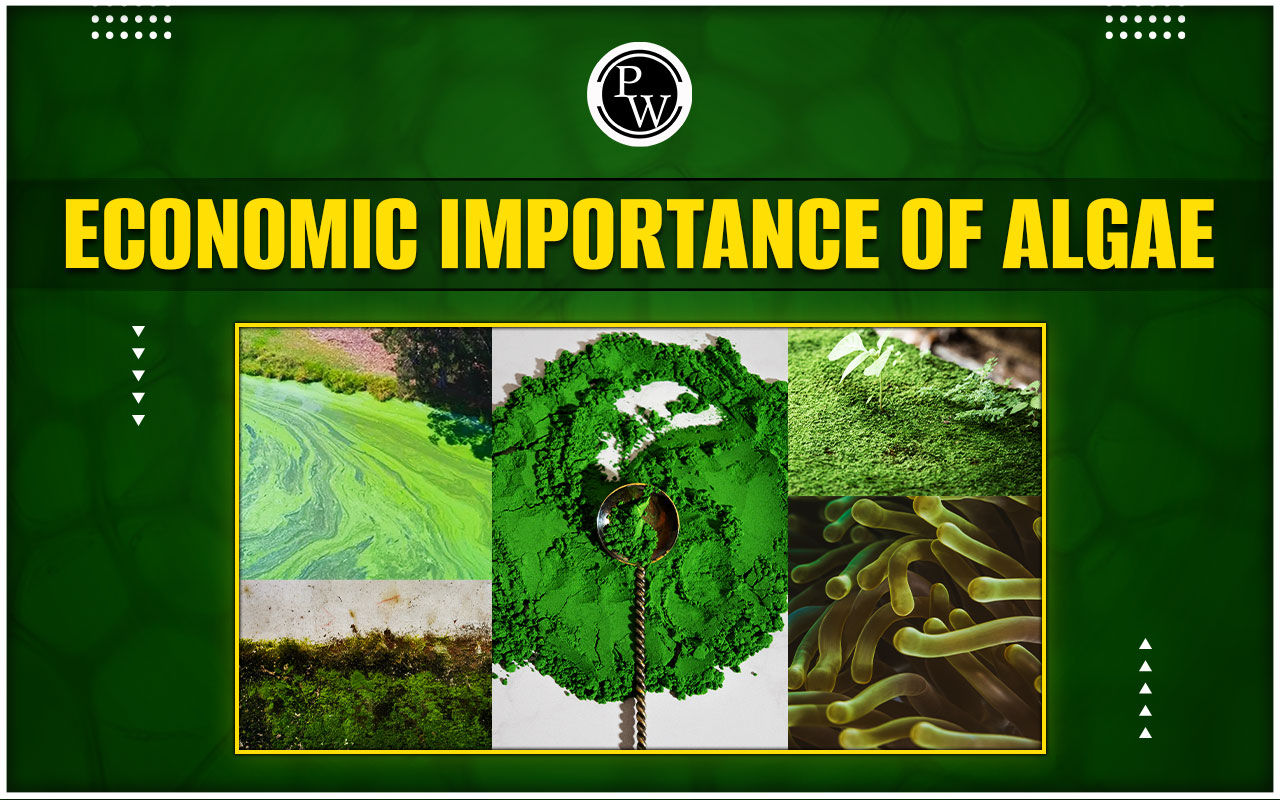

Economic Importance of Algae: Algae are tiny living things found worldwide. They come in many shapes, sizes, and colours. Some algae can live independently, while others grow on other living things, soil, or rocks. These creatures are important because they produce much oxygen that people and other animals need to breathe. Some algae, like seaweed, look similar to plants.
Algae can be very small or large and live in many different places. Microscopic algae in lakes and oceans, called phytoplankton, float or swim around. Phytoplankton are so small that you could fit one thousand of them on the head of a pin.
Algae are a wide variety of water plants that use sunlight to make food. Like most plants, they don't have flowers, roots, leaves, or stems. Algae can be as small as one cell or as large as giant kelp. Algae are important because they provide food for fish farming, can be used as feed, and are also used as a fertilizer. They also help to balance the pH levels of water, can be used to bind soil, and are used in many different products. More information about the Economic Importance of Algae can be found in the NEET Biology Notes in the article below.
Economic Importance of Algae
The economic importance of algae can be outlined as follows:
1. Algae as a Foundation of Food Chains
Algae in fresh and saltwater environments, are vital in many food chains. They produce organic food, just like plants on land. This food is crucial for fish and other aquatic animals, directly or indirectly.
Various types of algae, like diatoms, filamentous algae, planktonic green algae, and blue-green algae, are commonly found in the digestive systems of different freshwater and brackish water fish, indicating their direct use as fish food. These algae contain fats, starch, sugars, glycogen, and polysaccharides, which are important for fish nutrition.
2. Algae Useful in Fish Farming
Algae play a crucial role in fish farming. For example, the Siamese fish Tilapia mossambica, thrives on filamentous algae. This fish has been successfully introduced in various regions of India, with Scenedesmus cultures often used as a daily fish meal.
3. Use of Algae in Recreational Purposes
Some algae are grown intentionally in recreational areas such as lakes and streams, where they coexist with fish, enhancing their overall aesthetic appeal and recreational value.
4. Algae Usage in Sewage Treatment
Algae, including Chlamydomonas, Scenedesmus, Chlorella, and Euglena, are used in sewage treatment plants. Through photosynthesis, these algae provide the oxygen required for the rapid decomposition of sewage by bacteria.
5. Algae and Water Quality
In summer, algae, including phytoplankton, can increase in ponds, lakes, and reservoirs, leading to water blooms. This excessive algal growth can result in cloudy water with a yellowish or greenish tint, along with the formation of scum on the surface. Water blooms are aesthetically displeasing and threaten public water supplies and recreational activities like bathing and fishing.
Certain algae, mainly blue-green algae, can release toxins harmful to fish and domestic animals. Moreover, the presence of algae in reservoirs can increase the chlorine requirement for bacterial control and complicate filtration processes due to their organic matter content.
6. Algae Useful in Petroleum, Gas, and Oil Formation
Scientists think oil and gas are made from ancient plants' photosynthesis, like coal. Unlike coal, which forms in swamps, oil and gas come from dead plants and animals in the sea. Tiny sea plants called plankton are essential. They use sunlight to make energy, moving to animals that eat them. The dead plankton's organic matter gathers in mud in shallow sea areas.
Over time, this organic matter turns into oil and gas due to pressure and lack of oxygen. Natural gas, mostly methane (CH4), can also form from specific bacteria. Gas often comes with oil and forms when methane-making bacteria act on organic matter.
7. Algae's Role in Making Limestone
Some algae take calcium from water, both fresh and salty, and put it in their cell walls as calcium carbonate. Blue-green and red algae are important, along with some green algae and flagellates. Blue-green algae are key in freshwater areas, creating limestone near hot springs and glaciers.
Red algae are crucial in the sea, especially for coral reefs. While coral is made by tiny animals, red algae that make lime are almost as important. They are common in warm seas but also in cold areas, making limestone along coasts.
8. Algae Useful in Space and Science
Chlorella helps in space travel by keeping air clean in long journeys. Stale air with too much carbon dioxide is sent into a container with water, nutrients, and Chlorella. The algae use sunlight to turn carbon dioxide into oxygen. Chlorella, Chlamydomonas, and Acetabularia are also used in basic science research.
9. Algae Usage as Food
Algae have been eaten for a long time. Chinese records mention seaweeds in medicine thousands of years ago. Japanese people ate seaweed with rice. Kombu, made from a type of seaweed, is a Japanese food. Polynesians and Hawaiians also ate many seaweed types. Irish moss was popular in Europe and used in dishes like blancmanges. Algae give carbohydrates, vitamins (especially A and E, with some C and D), and iodine (which prevents goiter). They also act as a mild laxative.
Chlorella has as much vitamin B as lemon juice. In Japan, powdered Chlorella is mixed with green tea. Researchers have studied the use of mass-produced chlorella in Germany and the United States as food for animals and humans.
10. Algae Used as Livestock Feed
Algae, particularly marine algae, have been used as food for livestock like goats, cows, and sheep. In places like Iceland, Scandinavia, and the British Isles, animals are allowed to graze on seaweeds at low tide. Algae-fed animals show better digestion, and during World War I, when grain was scarce in Europe, seaweeds were experimented with as feed for cows and horses.
11. Algae Used as Fertilizer
Seaweeds are valuable for fertilizing soil. In regions like Britain and France, seaweeds were harvested for manure. They improve soil quality by slowly decaying and forming humus, which benefits plants. Certain types of blue-green algae have been found to increase rice yields when added to paddy fields.
12. Algae Used as Medicine
Algae have been used in traditional medicine for various purposes. Chinese medicine, for example, used certain types of algae to treat glandular issues and stomach disorders. Agar, extracted from certain algae, has been used for stomach disorders and as a laxative. It has also been essential for bacterial cultivation in medical research laboratories.
13. Industrial Uses of Algae
Algae have industrial applications as well. Historically, 'kelp' was used in Europe to extract soda for glass-making. Today, algae extract chemicals like alginates, which have various industrial uses. Red algae produce agar, which has many applications in medical laboratories.
PW offers NEET Online Coaching the tailored courses and comprehensive preparation materials for Class 12 NEET aspirants, including live classes, PDF notes, practice problems, and doubt-solving support from faculty and peers. Tests track progress.
| NEET Exam Important Links | |
|---|---|
| NEET Biology Syllabus | NEET Biology Diagrams |
| NEET Biology MCQ | NEET Biology Chapter wise Weightage |
| NEET Biology Notes | NEET Previous Year Question papers |
Economic Importance of Algae FAQs
What are the economic benefits of algae and gymnosperms?
What is the economic importance of algae in agriculture?
What is the economic significance of algae in Shaalaa?
What is the significance of algae?












